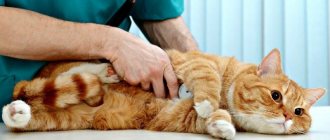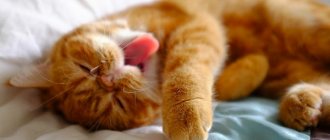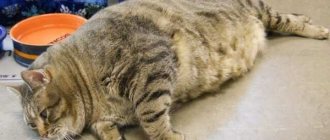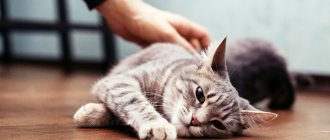One of the most commonly diagnosed digestive system diseases in domestic cats is gastric ulcers. The disease is a pathology of the mucous membrane of an organ, characterized by the formation of ulcers and the development of necrosis.
The main cause of the disease is an error in feeding the animal, but there are other negative factors. A dangerous complication of an ulcer is bleeding and perforation of the gastric mucosa. Treatment requires patience from the owner and strict adherence to the veterinarian’s recommendations.
What is a stomach ulcer and how does it occur?
An ulcer is nothing more than a local defect that affects the mucous layer of the stomach wall, sometimes involving the deeper submucosal layer. It occurs under the influence of irritants that are constantly present in the stomach - hydrochloric acid of gastric juice and the enzyme pepsin.
Normally, the organ is protected from the effects of these factors by mucus, hormones, and an epithelial barrier, but if for some reason the synthesis of mucus and hormones is disrupted, the protection loses its properties, and the aggressive environment affects the mucosal area, causing trophic disorders in it.
Reasons that weaken the protective properties of the gastric mucosa in cats include:
- reproduction of bacteria Helicobacter Heilmannii (analogue of human Helicobacter Pylori);
- taking non-steroidal anti-inflammatory drugs;
- tumors of the gastrointestinal tract;
- foreign body in the stomach;
- systemic diseases (diabetes mellitus, renal failure);
- unhealthy diet (human food with salt and spices, low-quality feed);
- stress (increased tone of the vagus nerve stimulates increased production of gastric juice).
If the process involves deeper layers of tissue, the stomach wall may perforate, then they speak of the occurrence of a perforated ulcer, which causes complications - life-threatening bleeding and peritonitis.
Gastric ulcers in cats can be acute, but most often it is a chronic process (the so-called peptic ulcer) with periods of remissions and exacerbations. It can be simple or progressive, and vary in location in the organ. The healing of the ulcer is accompanied by the development of a connective tissue scar at this site.
Diagnostics
To diagnose a stomach ulcer in a dog, a whole range of tests and a set of diagnostic measures are used. Since the disease can lead to potentially life-threatening consequences for the animal, in addition to diagnosing the ulcer itself, it is also necessary to check the functions of internal organs, the functioning of blood cells, digestive organs, and study hormonal levels.
Clinical blood test
– is important for excluding anemia in an animal with peptic ulcer disease (since a fairly large volume of blood can be lost through bleeding ulcers and sometimes a blood transfusion is required), shows the presence of a strong inflammatory process, allows you to determine the number of platelets (cells associated with blood clotting).
Biochemical profile
blood helps to evaluate the functioning of the kidneys, liver, electrolyte balance, total protein content, blood sugar levels. All these parameters are important for animals with already diagnosed gastric ulcers, since these tests can determine the primary disease, or whether it is associated with any metabolic disorders.
Analysis of urine
– helps evaluate kidney function and the level of dehydration in the animal.
Fecal occult blood test
– examined to look for digested blood (from the upper gastrointestinal tract), which is a symptom of a gastric ulcer.
Abdominal x-ray
– to exclude the presence of a foreign body or tumor in the stomach (which gives the same symptoms as a peptic ulcer).
X-ray contrast examination of the stomach with barium
– informative for identifying ulcers. In addition, barium is used to diagnose foreign bodies in the stomach and tumors. A safe dye is given to the patient by mouth, and then a series of X-rays are used to monitor the barium's passage through the gastrointestinal tract. Also, with the help of such a study, perforation (perforation) of the stomach wall is diagnosed.
Abdominal ultrasound
– evaluates the structure of the abdominal organs and excludes the presence of tumors. Ultrasound is also used for monitoring biopsies of tumors, lymph nodes, and liver.
Gastroscopy
- This is an examination of the inner surface of the stomach using an endoscope, which is inserted into a cat or dog through the mouth. The study is carried out under sedation. As a result of this study, the presence of ulcers and tumors is revealed, biopsy material is taken for histological and cytological examination, and foreign objects are removed.
Coagulogram
(blood coagulation test) - may be recommended in cases where a blood clotting disorder is suspected. A bleeding disorder can produce the same symptoms as a stomach ulcer - bloody vomiting, bloody diarrhea.
ACTH test
– recommended to exclude hypoadrenocorticism (Addison's disease), which can cause gastrointestinal ulcers.
Bile acids
– are determined to evaluate liver function, since some liver diseases can cause stomach ulcers.
Measuring blood lead levels
– may be tested in a patient with a peptic ulcer if it is known that there is a possibility of lead poisoning.
Gastrin level
– Investigated in any patient with multiple or recurrent ulcers or signs of ulceration. Elevated gastrin levels are usually observed in patients with gastrinomas (tumors that secrete gastrin), resulting in increased production of hydrochloric acid in the stomach, which contributes to the development of peptic ulcers.
Diagnostic laparotomy
is an operation in which a veterinary surgeon can examine organs, confirm the diagnosis, and, if necessary, take tissue samples for histological analysis. Diagnostic laparotomy is usually performed when other types of diagnostics have not given the desired result.
Symptoms of a stomach ulcer in a cat
When a cat has a stomach ulcer, the symptoms and treatment largely depend on the characteristics of the inflammatory process.
The clinical picture in the chronic form of the disease can be blurred, since only nonspecific signs of the disease appear:
- severe weight loss;
- periodic vomiting after eating;
- depressed state;
- dull coat;
- changes in stool;
- change in appetite (most often it increases).
More specific signs include:
- abdominal pain on palpation;
- gray coating on the tongue;
- anemia (pallor) of mucous membranes;
- development of gastric bleeding.
The last symptom is the most dangerous. Depending on the degree of development of the process and the type of ulcer, bleeding of varying intensity can be observed.
Small streaks of blood in vomit most often do not pose a danger, as they develop as a result of the destruction of the surface capillaries of the esophageal mucosa during prolonged vomiting.
With moderate to severe bleeding, the blood coagulates in the stomach under the influence of gastric juice, and the vomit looks like a dark brown mass. The feces take on a black tint. Vomiting bright scarlet blood means severe damage and possible perforation of the stomach wall, which requires immediate surgical intervention.
Perforation of the ulcer causes the animal to go into shock, but after some time an imaginary improvement may be observed due to a disruption in the functioning of pain receptors in the damaged areas.
Pathologies of bacterial origin
Perhaps the most numerous and “diffuse” group. Diseases of this group can be caused by Campylobacter, Helicobacter, Clostridia, Salmonella, pathogenic strains of Escherichia coli, etc. Moreover, with many diseases of bacterial etiology, even if not directly related to damage to the intestines, diarrhea and other problems with the gastrointestinal tract are an annoyingly common phenomenon, so there can be a lot of reasons.
As a rule, the activity of pathogenic microflora leads to the development of severe inflammation of the small and large intestines (enteritis and colitis, respectively). The result is constant diarrhea. Fecal matter is yellowish-brown in color, sometimes it turns greenish, and significant amounts of blood can often be seen in the stool. This happens due to serious damage to the intestinal walls and hemorrhages that develop as a result.
Importance of diagnosis
For any infection of bacterial origin (even if it is suspected), diagnosis plays a huge role. This includes the following techniques:
Blood biochemistry, which allows you to assess the condition of the liver and kidneys, as well as the endocrine glands.
A complete blood test to detect inflammation, identify pathogens directly in the blood, anemia, and other dangerous pathological conditions.
Blood plasma analysis (serological). Extremely useful in identifying a specific type of pathogen.
Contrast radiography of the abdominal cavity is also shown.
Ultrasound of the digestive organs. Ultrasound examination, as well as radiography - all these techniques allow us to assess the real state of the digestive system.
Endoscopy with an accompanying biopsy is also recommended. The materials obtained in this case will be used for cytological microscopic examination.
Therapeutic techniques
First, treatment implies the need to urgently relieve dehydration and diarrhea. For this purpose, compounds are infused intravenously to help relieve intoxication and restore the balance of electrolytes in the animal’s blood, astringents are prescribed, and sedatives and painkillers may be administered.
Specific therapy is based on the use of antibiotics and other antimicrobial drugs. But! They should be given to the cat only after the specific causative agent of the disease has been accurately identified through microscopic examination and/or plating of pathological material on nutrient media. There is no need to stuff your cat with potent medications “just like that,” as this can lead to serious consequences.
The health of the whole organism depends on the normal functioning of the intestines in cats, as in other living beings, but if for any reason a malfunction occurs, various diseases develop. The causes of intestinal diseases in cats can be various infections, helminths, stress, errors in feeding, poisoning, foreign bodies, coprostasis (slowing the movement of feces in the intestines), hairballs (trichobezoars), intussusceptions, tumors.
Establishing diagnosis
Suspicion of a peptic ulcer arises from the combination of the listed symptoms. During the examination, the doctor notes severe pain in the abdominal area, cachexia, and pallor of the mucous membranes. A clinical blood test, as a rule, remains within normal limits; with severe bleeding, slight anemia is possible. The exception is complicated cases of ulcers.
The cat may be prescribed an X-ray examination with the introduction of contrast, ultrasound, and a biochemical blood test to exclude other pathologies of the abdominal cavity. An accurate diagnosis can be made using gastroscopy.
Such a common fecal occult blood test is not as informative for cats, since meat is an essential component of their diet, and correct results can be obtained only after a three-day protein-free diet.
Main symptoms of the disease
It is problematic to independently distinguish gastritis from gastric ulcer. The symptoms of these pathologies largely coincide, so to make an accurate diagnosis, we recommend contacting a veterinary clinic in Moscow.
Among the symptoms indicating the development of a stomach ulcer:
- severe pain,
- vomiting with blood,
- rapid weight loss,
- oppression,
- lethargic state
- constipation,
- pallor of the mucous membranes,
- black chair,
- elevated temperature,
- specific odor from the mouth.
Note! When palpating the abdominal area, cats experience pain: they worry, moan, and meow loudly.
Owners will immediately notice changes in the pet’s behavior: it becomes very lethargic and apathetic, practically does not move, and stops playing and running. He lies down, rests and sleeps more. Refuses to eat and drinks a lot.
Treatment of stomach ulcers in cats
To understand how to treat a cat’s stomach ulcer, it is necessary to establish the cause that caused it. The most common culprit of this disease in cats is poor diet, followed by stress.
Treatment for peptic ulcer disease includes:
- Diet food. These can be natural products or ready-made foods that are suitable for animals with gastritis (it is best to transfer them to such food for life).
- Sedatives. If the animal is experiencing constant stress, you need to eliminate the cause of the cat's anxiety and help it cope with this condition with the help of sedatives (on the recommendation of a doctor, these can be purchased at a veterinary pharmacy).
- Antacids and coating agents. The drugs of choice are almagel, phosphalugel - give the animal 1 ml 1-2 hours after feeding 2-3 times a day. The course is about 3 weeks.
- Medicines to reduce stomach acidity should be taken for a long time. Either proton pump inhibitors (omeprazole) or histamine-2 receptor antagonists (ranitidine) are used.
- For severe pain, antispasmodics are recommended.
- For frequent vomiting, antiemetics are prescribed.
- It is possible to use hemostatic drugs.
- For emaciated animals in serious condition, a course of infusion therapy with the introduction of vitamins and amino acids is indicated.
- In case of complications or suspicion of a bacterial nature of the disease, systemic antibiotics are prescribed.
- Severe bleeding can only be eliminated surgically. The appearance of a perforated ulcer is especially dangerous. In this case, the ulcer itself is excised and the edges of the wound are sutured.
- Surgical treatment is also used to eliminate causes of the disease such as a tumor or foreign body in the stomach.
Medical nutrition
Part of the treatment is the transfer of the pet to Royal Canin Gastro food.
It is recommended to treat ulcers in cats with the right diet. You should not give your pet dry food. But if the cat loves it very much, it is necessary to soak it in water before using it. You also need to exclude coarse and tough foods from your diet; raw meat should be ground in a meat grinder. Meals should be fractional, divided into small portions. Treatment includes canned food "Royal Canin Gastro", "Hills", "Purina Veterinary Diets". You can offer your animal oatmeal with butter, lean broth, soft-boiled or hard-boiled egg yolk.
If the ulcer is not treated, it may perforate with the appearance of characteristic symptoms: a decrease in body temperature by 2 degrees, pale mucous membranes, heavy breathing. What needs to be done to eliminate the consequences is demonstrated by a specialist from the Veterinary clinic Beethoven in practice (issue “Perforated ulcer in a cat”).
How to treat a cat's stomach ulcer at home
In situations where it is impossible to provide qualified veterinary care, you have to resort to therapeutic measures on your own. Unfortunately, in case of severe bleeding or perforation, help can only be provided through emergency surgery. But in most cases, peptic ulcer disease develops gradually and is chronic.
The sooner the owner notices warning signs, the more effectively he can help. Nonspecific symptoms of the ulcer resemble gastritis, and treatment will be similar.
Necessary:
- Review your diet. It is best to put your cat on a special veterinary diet.
- Take phosphalugel or almagel as indicated above.
- Provide the animal with rest.
At the first opportunity, it is advisable to show the cat to a veterinarian to correct treatment and confirm the diagnosis. It must be taken into account that the disease can worsen in spring and autumn.
A stomach ulcer in a cat is a serious disease that requires a responsible approach on the part of owners. You should not delay treatment - when the first symptoms appear, it is better to have the animal checked for possible problems by a trusted specialist.
Preventing stomach problems
The primary thing is proper nutrition and a balanced diet, varied food rich in vitamins and minerals. Give your cat only high-quality food, taking into account the breed, weight, age and individual characteristics of the body.
Do not use low-quality budget food, do not feed your pet human food and bones, which can injure the digestive tract and lead to serious health problems.
Hide household chemicals and anything that can cause poisoning away. Don’t be lazy to take your cat for a preventive examination and tests if he has reached old age.
The optimal food temperature for a cat is room temperature, so do not give it frozen or hot foods. Keep an eye on their freshness and quality.
Sources:
https://aroundpet.ru/yazva-zheludka-u-kota-simptomy-i-lechenie/
https://berloga.vet/articles/yazva-zheludka-u-koshki/
https://kinpet.ru/yazva-zheludka-u-koshek-i-kotov/











